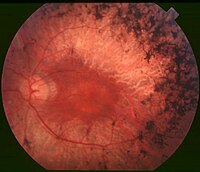
The phenotypic and genotypic features of Chinese patients with oculopharyngeal muscular dystrophy
Sign Up to like & getrecommendations! Published in 2023 at "Annals of Clinical and Translational Neurology"
DOI: 10.1002/acn3.51733
Abstract: Oculopharyngeal muscular dystrophy (OPMD) is a late‐onset inherited neuromuscular disorder, with progressive ptosis and dysphagia as common manifestations. To date, OPMD has rarely been reported among East Asians. The present study summarizes the phenotypic and… read more here.
Keywords: phenotypic genotypic; muscular dystrophy; chinese patients; oculopharyngeal muscular ... See more keywords

The small compound Icerguastat reduces muscle defects in oculopharyngeal muscular dystrophy through the PERK pathway of the unfolded protein response
Sign Up to like & getrecommendations! Published in 2023 at "Open Biology"
DOI: 10.1098/rsob.230008
Abstract: Oculopharyngeal muscular dystrophy (OPMD) is an autosomal dominant disease characterized by the progressive degeneration of specific muscles. OPMD is due to a mutation in the gene encoding poly(A) binding protein nuclear 1 (PABPN1) leading to… read more here.
Keywords: unfolded protein; muscle; muscular dystrophy; protein response ... See more keywords

Clinical and genetic features of a large homogeneous cohort of oculopharyngeal muscular dystrophy patients from the Canary Islands.
Sign Up to like & getrecommendations! Published in 2022 at "European journal of neurology"
DOI: 10.1111/ene.15252
Abstract: BACKGROUND Oculopharyngeal muscular dystrophy (OPMD) is an autosomal dominant, late-onset myopathy characterized by ptosis, dysphagia, and progressive proximal limb muscle weakness. The disease is produced by a short expansion of the (GCN)n triplet in the… read more here.
Keywords: muscular dystrophy; features large; oculopharyngeal muscular; cohort ... See more keywords

Activation of the ubiquitin-proteasome system contributes to oculopharyngeal muscular dystrophy through muscle atrophy
Sign Up to like & getrecommendations! Published in 2022 at "PLoS Genetics"
DOI: 10.1371/journal.pgen.1010015
Abstract: Oculopharyngeal muscular dystrophy (OPMD) is a late-onset disorder characterized by progressive weakness and degeneration of specific muscles. OPMD is due to extension of a polyalanine tract in poly(A) binding protein nuclear 1 (PABPN1). Aggregation of… read more here.
Keywords: opmd; muscle; activity; muscular dystrophy ... See more keywords

Swallowing, Chewing and Speaking: Frequently Impaired in Oculopharyngeal Muscular Dystrophy.
Sign Up to like & getrecommendations! Published in 2020 at "Journal of neuromuscular diseases"
DOI: 10.3233/jad-200511
Abstract: BACKGROUND Oculopharyngeal muscular dystrophy (OPMD) is a late onset progressive neuromuscular disorder. Although dysphagia is a pivotal sign in OPMD it is still not completely understood. OBJECTIVE The aim of this study was to systematically… read more here.
Keywords: opmd; swallowing chewing; muscular dystrophy; oculopharyngeal muscular ... See more keywords

A Case of Oculopharyngeal Muscular Dystrophy Caused by a Novel PABPN1 c.34G > T (p.Gly12Trp) Point Mutation without Polyalanine Expansion
Sign Up to like & getrecommendations! Published in 2023 at "Journal of Neuromuscular Diseases"
DOI: 10.3233/jnd-221669
Abstract: Immediately after the initial methionine codon, the PABPN1 gene encodes a stretch of 10 alanines, 1 glycine, and 2 alanines. Oculopharyngeal muscular dystrophy (OPMD) is caused by the expansion of the first 10 alanine stretches.… read more here.
Keywords: 34g gly12trp; muscular dystrophy; case; oculopharyngeal muscular ... See more keywords